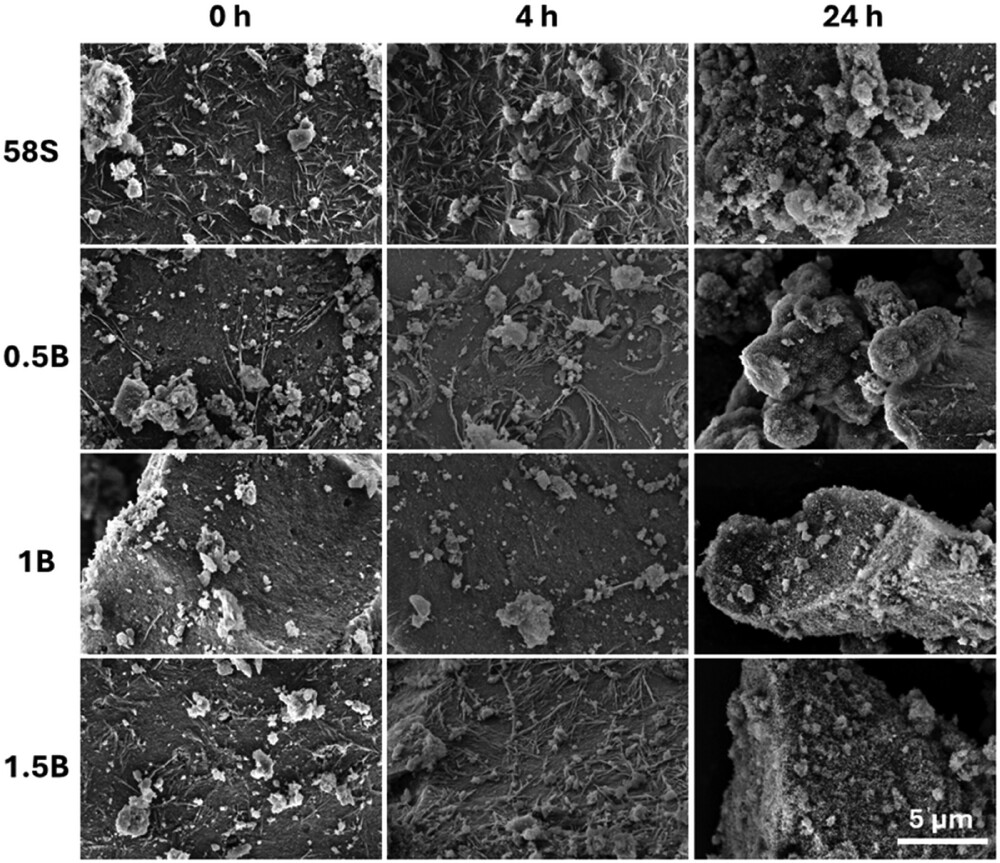Cytocompatible, radiopaque, and antibacterial bismuth-doped gel-derived 58S bioactive glasses.
CERQUEIRA, Glauber Rodrigues Cerqueira de; RODRIGUES, José Filipe Bacalhau; SHEARER, Adam; SCHNEIDER, José Fabian; DANTAS, Maria V. O.; SAMPAIO, Fábio Correia; NOGUEIRA, Paula Lima; CASTRO, Ricardo Dias de; MAURO, John C.; FOOK, Marcus Vinicius Lia; MONTAZERIAN, Maziar.
CERQUEIRA, Glauber Rodrigues Cerqueira de; RODRIGUES, José Filipe Bacalhau; SHEARER, Adam; SCHNEIDER, José Fabian; DANTAS, Maria V. O.; SAMPAIO, Fábio Correia; NOGUEIRA, Paula Lima; CASTRO, Ricardo Dias de; MAURO, John C.; FOOK, Marcus Vinicius Lia; MONTAZERIAN, Maziar.





 Abstract: Larry L. Hench's research group first introduced gel-derived bioactive glasses (BGs) in 1991. These BGs offer a broader range of bioactivity than traditional melt-derived BGs. Highly porous gel-derived glasses are suitable for various applications, such as bone and soft tissue engineering. The sol-gel process has significant versatility in developing BGs, and recent studies have investigated new compositions, including 58S glass (60SiO2-36CaO-4P2O5 mol%) modified with metal oxides. The addition of bismuth to BGs has recently been studied to enhance radiopacity, antibacterial properties, and effectiveness in cancer therapy. We investigated the effects of bismuth addition on the structural and biological properties of 60SiO2-(36 - x)CaO-4P2O5-xBi2O3 (x = 0, 0.5, 1, 1.5 mol%) gel-derived glasses. The glasses were prepared by hydrolysis and polycondensation of tetraethyl orthosilicate, triethyl phosphate, Ca(NO3)2·4H2O, and Bi(NO3)3·5H2O. They were characterized by Fourier transform infrared spectroscopy, X-ray diffraction, differential thermal analysis/thermogravimetry, and nuclear magnetic resonance after successfully converting the gels to glass at 600°C. The in vitro bioactivity, cytotoxicity, antimicrobial activity, and radiopacity of all samples were then analyzed. We found that glasses with 0.5, 1, and 1.5 mol% bismuth can be synthesized via a simple sol-gel route. In vitro tests confirmed that hydroxycarbonate apatite covers the surface of glass particles after 24 h of immersion in simulated body fluid. An in vitro biocompatibility assay demonstrated that the new materials are non-cytotoxic and antibacterial against Escherichia coli. Furthermore, the glass doped with 1.5 mol% of bismuth exhibited radiopacity equivalent to a 3.05 mm aluminum scale, meeting
Abstract: Larry L. Hench's research group first introduced gel-derived bioactive glasses (BGs) in 1991. These BGs offer a broader range of bioactivity than traditional melt-derived BGs. Highly porous gel-derived glasses are suitable for various applications, such as bone and soft tissue engineering. The sol-gel process has significant versatility in developing BGs, and recent studies have investigated new compositions, including 58S glass (60SiO2-36CaO-4P2O5 mol%) modified with metal oxides. The addition of bismuth to BGs has recently been studied to enhance radiopacity, antibacterial properties, and effectiveness in cancer therapy. We investigated the effects of bismuth addition on the structural and biological properties of 60SiO2-(36 - x)CaO-4P2O5-xBi2O3 (x = 0, 0.5, 1, 1.5 mol%) gel-derived glasses. The glasses were prepared by hydrolysis and polycondensation of tetraethyl orthosilicate, triethyl phosphate, Ca(NO3)2·4H2O, and Bi(NO3)3·5H2O. They were characterized by Fourier transform infrared spectroscopy, X-ray diffraction, differential thermal analysis/thermogravimetry, and nuclear magnetic resonance after successfully converting the gels to glass at 600°C. The in vitro bioactivity, cytotoxicity, antimicrobial activity, and radiopacity of all samples were then analyzed. We found that glasses with 0.5, 1, and 1.5 mol% bismuth can be synthesized via a simple sol-gel route. In vitro tests confirmed that hydroxycarbonate apatite covers the surface of glass particles after 24 h of immersion in simulated body fluid. An in vitro biocompatibility assay demonstrated that the new materials are non-cytotoxic and antibacterial against Escherichia coli. Furthermore, the glass doped with 1.5 mol% of bismuth exhibited radiopacity equivalent to a 3.05 mm aluminum scale, meeting @article={003246945,author = {CERQUEIRA, Glauber Rodrigues Cerqueira de; RODRIGUES, José Filipe Bacalhau; SHEARER, Adam; SCHNEIDER, José Fabian; DANTAS, Maria V. O.; SAMPAIO, Fábio Correia; NOGUEIRA, Paula Lima; CASTRO, Ricardo Dias de; MAURO, John C.; FOOK, Marcus Vinicius Lia; MONTAZERIAN, Maziar.},title={Cytocompatible, radiopaque, and antibacterial bismuth-doped gel-derived 58S bioactive glasses},journal={Journal of the American Ceramic Society},note={v. 108, n. 7, p. e20516-1-e20516-19},year={2025}}
@article={003246945,author = {CERQUEIRA, Glauber Rodrigues Cerqueira de; RODRIGUES, José Filipe Bacalhau; SHEARER, Adam; SCHNEIDER, José Fabian; DANTAS, Maria V. O.; SAMPAIO, Fábio Correia; NOGUEIRA, Paula Lima; CASTRO, Ricardo Dias de; MAURO, John C.; FOOK, Marcus Vinicius Lia; MONTAZERIAN, Maziar.},title={Cytocompatible, radiopaque, and antibacterial bismuth-doped gel-derived 58S bioactive glasses},journal={Journal of the American Ceramic Society},note={v. 108, n. 7, p. e20516-1-e20516-19},year={2025}}